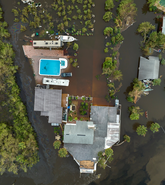Although the year had fewer extreme global loss events, 2023 was characterized by a high number of locally significant events; according to preliminary market estimates, these events collectively resulted in estimated insured losses close to the recent five-year average and above the recent 10-year average.
Losses in the last seven years have averaged more than US$100 billion per year, posing significant and continuing challenges in understanding, managing, and pricing future weather-related risks.
However, the industry must continue to measure and benchmark losses against reported losses, rather than just compare to reported global modeled insured average annual loss metrics.
‘Secondary’ Perils Dominate: Wildfires, Floods, and Severe Convective Storms
Moody’s RMS recently published its comprehensive 2023 Catastrophe Review report recapping the biggest events of 2023; customers can download the report from the Support Center or explore the main global events of the year on our interactive 2023 Catastrophe Review Report website here.
Questions now arise about whether ‘secondary’ perils should be classed as secondary at all, as losses from these non-peak perils start to mount up. Starting with wildfire, while the contiguous western U.S. was spared a major wildfire loss event in 2023, Hawaii did experience a devastating wildfire.
Destroying most of the city of Lahaina, on Maui’s western coast, it proved yet another illustration of the role of urban conflagration, as seen in recent major wildfires on the mainland.
Across North America, it was Canada that unfortunately suffered its most destructive wildfire year on record. More than 6,500 fires were recorded during 2023 spanning from Nova Scotia in the east to British Columbia in the west, providing a reminder to the industry about the danger outside of the commonly assumed areas of high wildfire risk.
Even without the industry losses driven by an EF-5-rated tornado, a large-scale tornado outbreak, or a multistate large-scale derecho event, the U.S. had still experienced its costliest severe convective storm (SCS) year. When the multitude of severe convective storm events are aggregated, 2023 produced overall estimated SCS losses exceeding US$52 billion.
Europe also experienced significant severe convective storm losses in 2023; insured losses from July’s hailstorms in Italy are expected to be well above US$2.2 billion (€2 billion), despite the relatively low insurance penetration rate.
From California to Italy, through to New Zealand, Hong Kong, and China, flooding events were another recurring theme that extended into 2023, with reports of widespread flooding, and many record-breaking events either for their rainfall or losses.
It is predominantly these so-called ‘secondary’ perils such as flood, wildfire, and severe convective storms, along with large exposure changes, social inflation, and non-modeled losses, that have contributed significantly to overall economic and insured losses in recent years. This should be a wake-up call for the industry to better assess, manage, and transfer the risk of future climate-related events.
Hurricane Idalia: Smaller Impact than Recent U.S. Events
While 2023 was the fourth most active North Atlantic hurricane season on record in terms of the number of named storms, only one hurricane made landfall in the U.S., and it was the most intense hurricane on record to make landfall in Florida's Big Bend region.
In late August 2023, Hurricane Idalia caused catastrophic wind and storm surge damage in southwestern and central Florida.
Unlike Hurricane Ian in late September 2022, Idalia is expected to have a considerably smaller impact on overall (re)insurance market dynamics, due to Idalia’s compact radius of maximum winds resulting in the strongest winds being limited to a small area near landfall in a sparsely populated section of the Florida coastline.
Moody’s RMS estimates insured losses from Hurricane Idalia in the U.S. to be between US$3 and US$5 billion, with a best estimate of US$3.5 billion.
Hurricane Otis: Record-Breaker for Mexico
One of the most remarkable events of 2023 was Hurricane Otis. Towards the end of October 2023, Otis unexpectedly rapidly intensified over the Eastern North Pacific, making a direct landfall as a Category 5 major hurricane on the Mexican resort city of Acapulco.
The storm broke numerous records for intensity; the first Category 5 major hurricane to make landfall on the west coast of Mexico since recordkeeping began — and caused massive destruction in the city, wrecking many multistorey beachfront hotels and apartment buildings.
Aerial imagery and remote reconnaissance showed Otis caused some of the most incredible wind damage ever seen to modern-day high-rise structures.
Recovery efforts are expected to take months, if not longer, and Otis stands as a pertinent reminder of the risk of a major hurricane hitting a large U.S. city.
Southern Turkey Earthquakes
Responsible for the highest number of casualties of any event last year, a series of earthquakes in Turkey and northern Syria in February 2023 reminded the industry of the imminent devastation posed by major earthquakes.
The far-reaching collapse of structures, impacting buildings some several hundred kilometers away from the rupture site, pointed to the significant role of ground motion amplification coupled with local site effects, including substandard construction practices.
Despite the introduction of regulations and building codes, there was significant concern over subpar construction standards in Turkey.
Moody’s RMS estimates that the total economic loss from the earthquakes that struck Turkey is likely to exceed US$25 billion (TL471 billion), and the total insured loss is likely to exceed US$5 billion (TL94 billion).
Moody’s RMS Event Response Service
During 2023, Moody’s RMS Event Response team supported the industry by providing accumulation information footprints for 43 events, including detailed stochastic event selections or hazard footprints for the most significant of these major events.
Moody’s RMS stands ready to support and manage rapidly changing future risks by updating our models to reflect lessons learned from recent events and providing flexibility within applications to enable clients to add their own views of risk. As a result, Moody’s RMS approach to event response continues to evolve.
Striking a balance between timeliness and accuracy remains critical to ensure that we deliver the most credible analysis to our customers while increasing efficiency and continuing to reduce delivery timelines.
Click here to view our 2023 Catastrophe Review Interactive Report, which provides context and analysis of the year’s most notable industry events and key insights. For Moody’s RMS customers, the full report is available to download via the Support Center.









